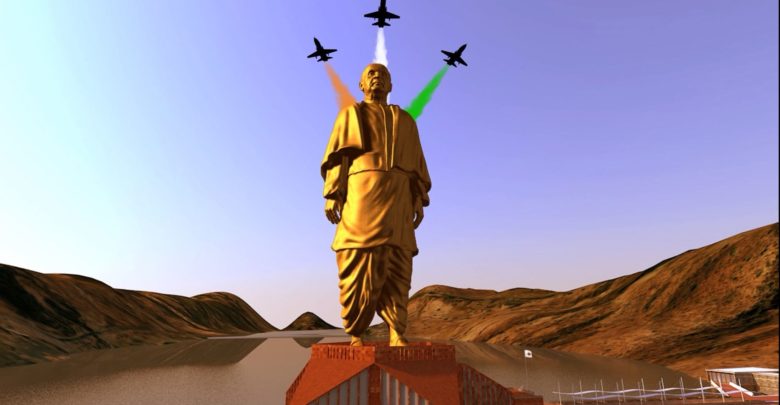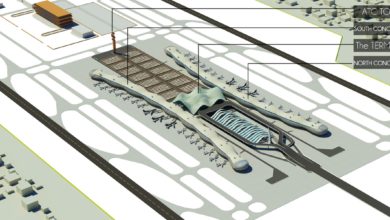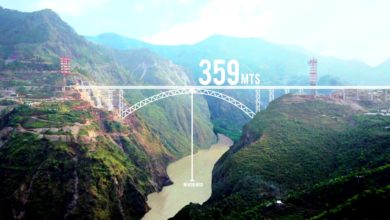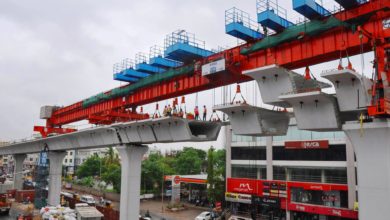The ‘Statue of Unity’
Larsen & Toubro is proud to have constructed it in a record time of 33 months

The ‘Statue of Unity’ (SoU) is dedicated to the Iron Man of India, Sardar Vallabhbhai Patel. A statesman par excellence, Sardar Patel is widely considered to be the architect of modern India. The SoU will stand tall as an inspiration to future generations, a reminder of Sardar Patel’s sterling contribution and a symbol of national harmony and integrity.
The Tallest in the World
At 182 meters from the road entry and 208.5 meters from the river entry, the SoU will be the tallest statue in the world; taller than the 153 m tall Spring Temple Buddha in China and almost twice as tall as the world famous Statue of Liberty in New York. For a sense of its height, the statue is 100 times larger than a man of average height of about 5 to 5 and a half feet!
A Towering Piece of Engineering
- The statue is conceived as a naturalistic depiction of Sardar Patel in characteristic garb in a walking pose
- It rises out of a star-shaped, geometric base that covers the entire Sadhu Hill
- It has a unique, slender width to height ratio, far more exacting than existing technical norms, that calls for special engineering considerations
- The structure has two vertical cores, each housing a high-speed passenger elevator
- The vertical cores support the steel frames to which about 6500 bronze panels are clad
- A viewing gallery at the 135 m level, at the chest, can accommodate up to 200 visitors at one go and affords a breath-taking view of the dam and its environs
A statue and more
- An exhibition centre at its base showcasing the life and achievements of Sardar Patel
- A 320 m long designer bridge connecting Sadhu Hill to the mainland
- A memorial and visitors’ centre
- 4-lane approach road
- An administrative complex, 3-star hotel and conference centre
- A 40-m suspended fabric roof structure for the visitors’ centre
Size in Numbers
- 210,000 cu.m. of cement concrete poured into the statue
- 18,500 tonnes of reinforced steel
- 6,500 tonnes of structural steel
- 1,700 tonnes of bronze
- 1,850 tonnes of bronze cladding made up of some 565 macro & 6,000 micro panels
Engineering Challenges
Wind, Earthquakes
Natural factors like wind and earthquakes posed stiff challenges. Situated right in the middle of the river Narmada, the statue is exposed to the tunnel effect of winds blowing down the river. Studies of wind patterns over the years revealed wind speeds of 39 m per second (roughly translated into 130 km/hr. ) could buffet the statue in a worst-case scenario.
The statue has been engineered to withstand wind speeds of up to 50 m per second (almost 180 km/hr. ). The challenge is not only of the wind blowing against the statue but the succession effect it creates at the back of the statue that had to considered in the structural design.
To arrest any sway of such a tall structure, two Tuned Mass Dampers of 250 tonnes each have been used. In any given situation, all the four corners of the base raft remain rooted to the ground.
The SoU can also survive earthquakes measuring up to 6.5 on the Richter Scale, at a depth of 10 km and within a radius of 12 km of the statue.
Walking pose of the Sardar
The Sardar’s legs are clad in a dhoti, his feet in chappals and in a walking pose that means that the statue is most slender at the base. This goes against the norms of what other tall statues have followed. The walking pose also opened up a gap of 6.4 meters between the two feet which then had to be tested to withstand wind velocity.
The face
Another challenge came in the form of the look of the statue. Since Patel’s face was an important aspect, special care was taken in casting the facial features that had to be as close as possible to the Sardar’s face. As per the sculptor Ram Sutar’s original design, the statue was to have a poised countenance, with Patel’s head held high and arms by his sides emitting a feeling of power as well as warmth. The statue is also supposed to appear as if it is walking on water, towards the Sardar Sarovar dam, with its left leg slightly forward.
The actual features of the Sardar were decided through a participative exercise involving thousands of people. A mock-up was created and exhibited for people to see and comment on it.
Movement of Men and Material
The statue is located amidst remote, mountainous terrain, which posed enormous difficulties in delivery of materials. A temporary Bailey’s bridge connected the hill to the mainland.
The statue base also stands above the highest flood level recorded over a 100-year period of the nearby Narmada dam. A detailed hydrological study was conducted by a specialist consultant to ascertain the river level and flow during various conditions.
Altogether, the statue is divided into five zones. Up to its shin is the first zone, comprising three levels, including an exhibit floor, mezzanine and roof. It will contain a Memorial Garden and a large museum.
Zone 2 extends up to the statue’s thighs at 149 metres, while Zone 3 goes up to the viewing gallery at 153 metres.
Zone 4 and Zone 5 would be out of reach of visitors, with Zone 4 comprising the maintenance area and Zone 5 the head and shoulders.
The viewing gallery will be accessible through two elevators located in the statue’s core, with a carrying capacity of 40 people each. The gallery, with space to accommodate up to 200 people at a time, will have a view of the Satpura and Vindhyachal mountain ranges, which also form the point where Madhya Pradesh, Gujarat and Maharashtra meet. Visitors can also get a distant view of the Sardar Sarovar Reservoir, and the 12-km-long Garudeshwar Reservoir — the latter will help ensure there is always water around the statue, which is located downstream from the Narmada dam.
In the lobby area at the entrance of the statue, a Museum and Audio Visual Gallery will feature 15-minute presentations on the life of Patel and the tribal culture of Gujarat, to entertain tourists awaiting their turn to go up.
The ’loha’ and earth campaigns
On December 15, 2013, the then Gujarat CM Narendra Modi had flagged off the campaign to 1,69,000 villages, carrying about three lakh empty kit boxes, to collect soil and scrap-iron farm implements. Subsequently, by 2016, 135 metric tonnes of iron were collected in various forms that have been used in the making of the statue. The collected earth from all parts of the country has been used in the making of the symbolic Unity Wall, and the Suraj Petitions received from this campaign are presented in digital, graphical form in the exhibition hall.
Source: www.larsentoubro.com






